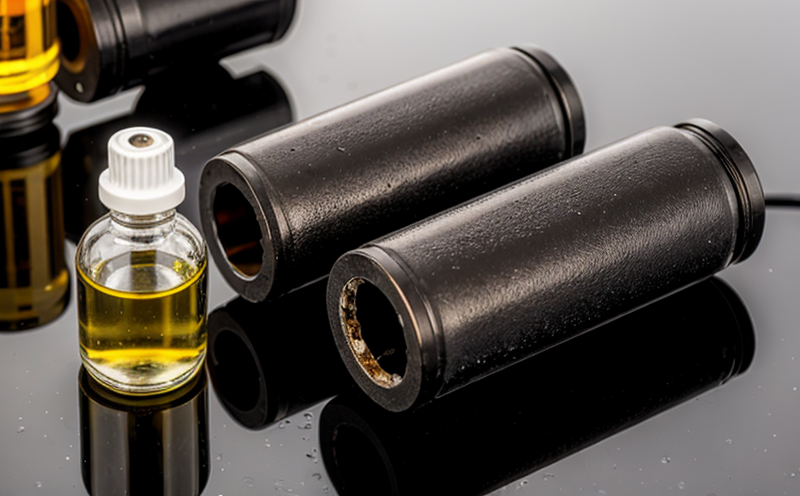ASTM D7679 Diesel Range Organics Hydrocarbons Test in Water
The ASTM D7679 test method is designed to determine the concentration of diesel-range organic hydrocarbons (DROH) present in water samples. This test is crucial for assessing contamination levels due to fuel spills or leaks, which can have significant environmental and health impacts.
Diesel-range hydrocarbons are a subset of petroleum-based compounds that include alkanes, cycloalkanes, and aromatic hydrocarbons. These components are typically found in diesel fuel and can persist longer in the environment compared to other lighter hydrocarbon fractions. Understanding their presence is essential for environmental monitoring and remediation efforts.
The test method specifies a range of carbon chain lengths from C10 to C25, which encompasses the majority of diesel components. By measuring these compounds, laboratories can provide accurate data on fuel contamination levels, aiding in regulatory compliance and environmental management strategies.
Compliance with ASTM D7679 is particularly important for industries involved in water treatment, petroleum refining, and environmental monitoring. It ensures that facilities are meeting local and international standards related to hydrocarbon emissions and discharge limits.
The test procedure involves several steps, including sample collection, preparation, and analysis using chromatographic techniques such as gas chromatography (GC). The GC instrument is equipped with a flame ionization detector (FID) or mass spectrometer (MS), which allows for precise quantification of the target compounds.
Sample preparation is critical to ensure accurate results. This involves diluting the water sample and extracting the organic hydrocarbons using either solvent-based methods or solid-phase extraction cartridges. The extracted components are then injected into the GC system for analysis.
The ASTM D7679 method provides detailed acceptance criteria, which define the acceptable limits of detected hydrocarbon concentrations. These limits vary depending on the specific application and regulatory requirements but generally aim to reflect realistic contamination levels that could impact water quality or human health.
By adhering to this standard, laboratories can provide reliable data to stakeholders involved in environmental protection initiatives, waste management programs, and compliance audits. The results of ASTM D7679 testing help decision-makers implement effective mitigation strategies and ensure ongoing compliance with relevant regulations.
Quality and Reliability Assurance
The reliability of ASTM D7679 results is ensured through rigorous quality control measures. Laboratories must maintain calibration standards, use certified reference materials, and perform method validation studies regularly. This ensures that the test data is accurate and can be relied upon for regulatory compliance.
Quality assurance (QA) programs involve continuous monitoring of laboratory practices to identify and correct any deviations from established protocols. Regular audits by independent bodies further enhance confidence in the results produced by ASTM D7679 testing.
In terms of reliability, the method's standardized procedures minimize variability in test outcomes. This consistency is particularly important for industries that rely on accurate hydrocarbon concentration data to make informed decisions regarding environmental impact assessments and remediation efforts.
For compliance officers responsible for ensuring regulatory adherence, ASTM D7679 testing offers a robust framework for monitoring fuel-related emissions and discharges. The test results can be used to justify actions taken to reduce contamination levels, thereby supporting broader sustainability goals within organizations.
Competitive Advantage and Market Impact
The ability to accurately measure diesel-range organic hydrocarbons in water samples provides a competitive advantage for laboratories by offering precise data that can inform strategic decisions. This information is valuable not only for compliance purposes but also for identifying potential sources of contamination.
For quality managers and R&D engineers, having access to reliable ASTM D7679 results enables the development of more effective treatment technologies and strategies. By understanding the specific types and concentrations of hydrocarbons present in water samples, these professionals can optimize processes and improve overall product quality.
The market impact of accurate ASTM D7679 testing extends beyond individual organizations to contribute positively to public health and environmental well-being. By reducing fuel-related contaminants in water supplies, laboratories play a crucial role in maintaining sustainable practices across various sectors.
Use Cases and Application Examples
| Use Case | Description |
|---|---|
| Environmental Monitoring | Detecting diesel-range organic hydrocarbons in surface water and groundwater samples to assess environmental impact. |
| Regulatory Compliance | Ensuring compliance with regulatory limits for fuel-related emissions and discharges from industrial facilities. |
| Water Treatment | Evaluating the effectiveness of water treatment processes in removing diesel-range hydrocarbons from contaminated sources. |
- Industrial wastewater discharge monitoring to ensure environmental compliance.
- Petrochemical plant emissions assessment for identifying and mitigating potential contamination issues.
- Oil spill cleanup effectiveness evaluation by measuring residual hydrocarbons in treated areas.
- Water quality benchmarking studies comparing pre- and post-treatment samples to assess remediation success.





